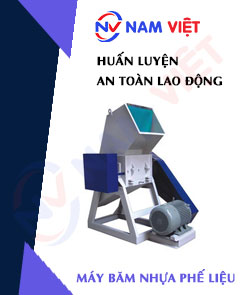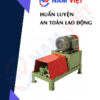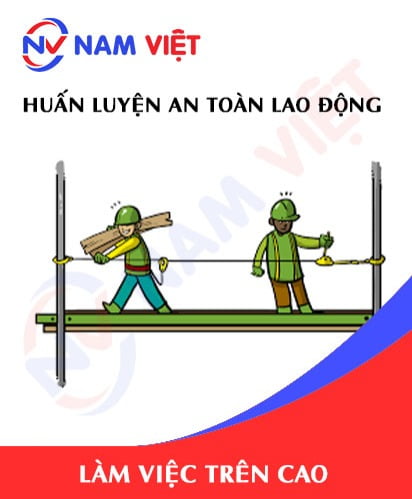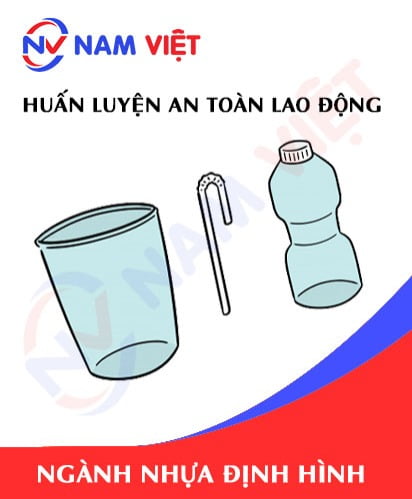Occupational Safety Training for Operating Plastic Shredder Machines
99,000 ₫
Note: The price above is calculated per person and may fluctuate depending on the number of participants in the course and market conditions. For more accurate pricing support, please refer to the price list or contact our consulting staff directly.
Occupational safety is an important issue when operating a plastic waste shredder and must be addressed promptly to ensure the health and safety of workers and enhance the reputation of businesses here. The Occupational Safety Training course is one of the effective solutions to raise awareness of how to prevent workplace accidents for workers operating a plastic waste shredder.
Table of Contents
Toggle1. Overview of Scrap Plastic Shredder Machine
a. What is a Scrap Plastic Shredder Machine?
A Scrap Plastic Shredder Machine is a device designed to shred scrap plastic into smaller pieces. This process helps reduce the size of the plastic and creates recyclable material that is easier to handle. This machine is commonly used in the plastic recycling process to produce new products from old plastic materials.

b. Operating Principle of Scrap Plastic Shredder Machine
The operating principle of a Scrap Plastic Shredder Machine generally includes the following steps:
- Material Feeding: Scrap plastic is fed into the machine through a feeding system.
- Cutting System: The machine uses cutting blades or a special cutting system to divide the plastic into smaller pieces. The blades may rotate or move in a specific pattern to shred the plastic.
- Shredding Process: The cut plastic is further shredded using mechanical or electrical force. The machine may apply rotational force, impact, or compression to break the plastic into smaller fragments.
- Residue Separation: After shredding, residues such as metals or other non-plastic materials may be present. A separation system can be used to remove these and collect the shredded plastic.
- Product Collection: The shredded and cleaned plastic is then collected to be used as recycled material.

c. Industries Using Scrap Plastic Shredder Machines
Scrap Plastic Shredder Machines are commonly used in the plastic recycling industry. Specifically, the following sectors frequently use this machine:
- Plastic Recycling Industry: Shredder machines help convert scrap plastic into recyclable material, reducing plastic waste and alleviating pressure on natural resources.
- Manufacturing Recycled Plastic Products: Companies producing recycled plastic products, such as water bottles, bags, pipes, etc., often use shredders to process the raw material.
- Plastic Processing Industry: Plastic processing companies may use shredder machines to recycle plastic waste from their production processes.
- Recycled Energy Production: Some shredder machines are used in recycled energy sectors, where shredded plastic serves as fuel sources.
2. Overview of Occupational Safety Training for Operating Scrap Plastic Shredder Machines
a. What is Occupational Safety Training?
- Occupational safety training for operating a Scrap Plastic Shredder Machine consists of sessions that equip workers with awareness of how to prevent workplace accidents. Workers who directly operate the shredder are classified as Group 3.
- The training course helps workers identify and avoid hazards, reducing the risk of workplace accidents.
REGISTER FOR OCCUPATIONAL SAFETY TRAINING SERVICE
b. Training Duration
Initial Safety Training Duration:
- Total training time is at least 24 hours, including assessment time.
- 8 hours of theory on safety policies and labor hygiene laws
- 8 hours of basic theory on occupational safety and hygiene
- 4 hours of specialized training theory
- 2 hours of practical training on specialized content
- 2 hours of theoretical assessment at the end of the course
The training center will divide the course into multiple sessions depending on workers’ schedules. Typically, there are 6 sessions over 3 days if the employer can arrange continuous training.
Periodic Safety Training:
- Before the occupational safety card expires, workers who wish to renew must attend a periodic occupational safety training with a duration of at least 50% of the initial training time.
Explanation: The total time for periodic occupational safety training is at least 12 hours, including assessment. After completing the periodic training and passing the test, workers will have their safety card renewed.
c. Training Course Content
| No. | TRAINING CONTENT | TRAINING TIME (HOURS) | |||
| Total | Including | ||||
| Theory | Practice | Assessment | |||
| I | Policies and Occupational Safety, Hygiene Laws | 8 | 8 | 0 | 0 |
| 1 | Overview of legal documents system on occupational safety and hygiene. | 6 | 6 | ||
| 2 | System of standards and technical regulations on occupational safety and hygiene. | 1 | 1 | ||
| 3 | Specific regulations from state management agencies regarding safety and hygiene in new, expanded, or renovated facilities, and the management of machinery, equipment, materials, and hazardous substances. | 1 | 1 | ||
| II | Basic Knowledge of Occupational Safety and Hygiene | 8 | 8 | 0 | 0 |
| 1 | Basic knowledge of hazards and harmful factors in the workplace. | 4 | 4 | ||
| 2 | Methods to improve working conditions. | 1 | 1 | ||
| 3 | Safety culture in production and business. | 1 | 1 | ||
| 4 | Rights and duties of employers and employees; occupational safety and hygiene policies; functions and duties of safety networks. | 1 | 1 | ||
| 5 | Safety regulations, signage, usage of safety equipment and personal protective equipment; first aid and occupational disease prevention skills. | 1 | 1 | ||
| III | Specialized Training Content | 6 | 4 | 2 | 0 |
| Comprehensive knowledge of machinery, equipment, hazardous substances; risk assessment and management for occupational safety; safe work procedures with machinery and hazardous substances. | 6 | 4 | 2 | ||
| IV | Final Assessment of Training Course | 2 | 2 | 0 | 0 |
| Total | 24 | 22 | 2 | ||
See more training content of all 6 groups
d. Occupational Safety Card
After completing the occupational safety training and passing the assessment, workers will be issued an Occupational Safety Card (commonly called a Group 3 Safety Certificate).
The Group 3 Safety Card shows personal information such as name, date of birth, job, and specific work environment. It also includes training duration, a red stamp, and signature confirming course completion.
According to Clause 2, Article 24, Decree 44/2016/ND-CP, there are 2 cases:
- If the employer and employee have a labor contract, the employer must sign, stamp, and validate the safety card for the Group 3 worker after they complete training from an occupational safety training provider and pass the assessment.
- If the worker is freelance or seasonal without a labor contract, the training provider must sign, stamp, and validate the safety card after the worker completes the training and passes the assessment.

Group 3 Occupational Safety Card for Operating Scrap Plastic Shredder Machine
3. Hazards When Operating Scrap Plastic Shredders
Operating a Scrap Plastic Shredder may involve certain hazards. Here are some common risks:
- Physical injuries: Moving parts, such as cutting blades and grinding components, can pose injury risks if safety rules are not followed. There is a risk of collision, cutting, or crushing if operators do not adhere to safety measures.
- Dust and toxic fumes: The plastic grinding process can generate plastic dust and fine particles, as well as toxic fumes. Inhaling plastic dust can harm operators’ health, especially if respiratory protection is not used.
- Heat and fire/explosion: Scrap Plastic Shredders can produce high temperatures during operation, particularly if the process is too fast or uncontrolled. High temperatures may cause fire, explosion, or damage to the machine.
- Residues and environmental impact: The shredding process can generate residues and waste, which, if not properly handled, may cause environmental pollution.
- Electrical hazards: If the machine uses electricity, there is a risk of high voltage and electric shock if safety measures are ignored.
To minimize hazards, it is important to follow safety rules, train operators, and maintain machinery properly.

4. Measures to Control Occupational Accidents When Operating Scrap Plastic Shredders
To control occupational accidents when operating Scrap Plastic Shredders, several key safety measures should be implemented:
- Training and guidance: Provide comprehensive training for operators, including explanation of hazards and safety measures, as well as instructions on proper machine use.
- Personal protective equipment (PPE): Ensure operators are equipped with PPE, including safety glasses, helmets, respiratory masks, and appropriate clothing.
- Regular machine inspection: Conduct routine checks and maintenance to ensure all components function correctly and are free from damage.
- Safe operating rules: Establish and enforce safety operating procedures, including adherence to all manufacturer instructions and occupational safety regulations.
- Work environment control: Maintain a healthy working environment by controlling dust and plastic particles, using effective ventilation systems, and providing respiratory protection.
- Electrical safety control: If the machine uses electricity, ensure the electrical system is safe and periodically inspected to prevent hazards.
- Designated safe zones: Set up safe areas for operators, separated from moving machine parts.
- Emergency escape measures: Establish safety measures for quickly exiting the machine in emergencies.
- Incident recording and reporting: Implement a system to record incidents and report immediately for investigation and prevention of recurrence.
- Monitoring and evaluation: Continuously monitor and evaluate machine safety performance to improve the safety system as needed.
- Periodic inspection of Scrap Plastic Shredders to detect safety issues such as wear, tear, or mechanical failures early, thereby reducing the risk of occupational accidents.
5. Benefits of Occupational Safety Training
An Toàn Nam Việt provides businesses with the following benefits upon completing occupational safety training courses according to Decree 44/2016/ND-CP on Occupational Safety and Hygiene for companies, factories, and enterprises:
- Workers can recognize potential occupational hazards and take preventive measures to avoid accidents.
- Businesses can establish risk prevention measures in production, operation, and maintenance processes.
- Minimizes costs associated with workplace safety risks.
- Ensures uninterrupted production, increasing labor productivity and product quality.
- Compliance with occupational safety laws, avoiding legal risks.
- Enhances credibility and professionalism, thereby improving the company’s brand.
Nam Việt’s training courses provide protection against external hazards, enabling individuals to avoid injury or even fatal accidents.
REGISTER FOR OCCUPATIONAL SAFETY TRAINING
6. Customer Feedback After Completing Training
An Toàn Nam Việt has years of experience accompanying many businesses across Vietnam, especially in the southern provinces. This responsibility is highly valued, and therefore Nam Việt’s Occupational Safety Training is increasingly professional. The motivation for Nam Việt’s growth comes from positive feedback and suggestions from our corporate partners. Below are some testimonials from our clients:
See more customer interviews after using our services at An Toàn Nam Việt
7. Occupational Safety Training Capability of An Toàn Nam Việt
An Toàn Nam Việt is a reputable and high-quality occupational safety training center in Vietnam, conducting training continuously at production workshops, factories, and construction sites nationwide (all 63 provinces of Vietnam).
REGISTER FOR OCCUPATIONAL SAFETY TRAINING
Occupational safety training license
- An Toàn Nam Việt has been inspected and certified by the Department of Safety under the Ministry of Labor – Invalids and Social Affairs as meeting the requirements to conduct occupational safety and hygiene training. This further strengthens our training capability.

Training materials and lectures
- Before being used in OST courses, materials are reviewed to ensure accuracy and effectiveness.
- Teaching methods are standardized according to An Toàn Nam Việt standards, developed by occupational safety experts to maximize knowledge retention.
Facilities
- Control of classroom factors that affect training increases teaching efficiency and knowledge absorption.
- Our training facilities provide spacious classrooms meeting standards for size, lighting, and training equipment.
8. Nationwide Reputable Safety Training Center
At An Toàn Nam Việt, occupational safety training is our top priority. We aim to equip workers with self-protection knowledge for safe working conditions, contributing to national development.
To ensure training effectiveness, we carefully prepare every detail, from tools and teaching equipment to lesson plans, materials, audio, and lighting.
Our instructors are experienced safety experts, with research on hazard identification across industries and prevention methods.
Lectures are practical, engaging, and easy to understand, enabling learners to absorb knowledge effectively. All content aligns with Decree 44/2016/ND-CP.
Participants learn hazard prevention measures and self-protection techniques, applying them appropriately in real work situations.
Our training center prides itself on providing professional and reputable occupational safety training with advantages:
- Competitive training fees while ensuring high quality.
- Flexible scheduling aligned with company operations.
- Fast, legally compliant certification procedures.
- Experienced instructors with long-term expertise.
- Controlled classroom environment to improve teaching efficiency.
- Lectures tailored to occupational safety in enterprises.
- Dedicated, professional service to support customers quickly and accurately.

9. Additional Occupational Safety Training Materials
1 review for Occupational Safety Training for Operating Plastic Shredder Machines
No comments yet















phanminhhang341
Trung tâm huấn luyện an toàn lao động chuyên nghiệp ở Việt Nam nha